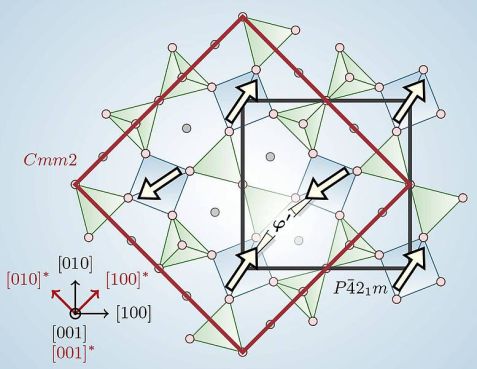MLZ is a cooperation between:
 > Technische Universität München
> Technische Universität München > Helmholtz-Zentrum Hereon
> Helmholtz-Zentrum Hereon
 > Forschungszentrum Jülich
> Forschungszentrum Jülich
MLZ is a member of:
 > LENS
> LENS > ERF-AISBL
> ERF-AISBL
MLZ on social media:

MLZ (eng)
Lichtenbergstr.1
85748 Garching
07.12.2012
Symmetry decrypted
By means of neutron scattering, the crystallographic structure of a novel material with amazing phenomena at low temperatures was unraveled.

Neutron diffraction studies show that the magnetic structure of Ba2CoGe2O7 has an orthorhombic symmetry and the spins order antiferromagnetically in a square lattice. (Source: V. Hutanu/A. Sazonov)
Materials, which spontaneously show at a certain temperature a long-range order at atomic level, are of great interest in materials science. A magnet is such an example: The external magnetism can be observed because at atomic level the magnetic moments of the substance, the spins, align parallel. If the substance displays at the same time multiple order phenomena, experts call them multiferroica and are particularly excited, if there is a magnetic and electrical order, because magneto-electric multiferroics are a hot topic for potential use in spintronics and data storage.
The multiferroic Ba2CoGe2O7 had attracted significant scientific interest because alongside with its peculiar magneto-electronic properties it simultaneously shows other unusual phenomena, such as magnetically excited vibrations in the crystal lattice or a directional-dependent velocity of electromagnetic waves. To explain these amazing observations, scientists have proposed various theoretical models. Thereby, it was assumed that the crystal structure of Ba2CoGe2O7 has a tetragonal symmetry. For the first time, the structure of the substance was studied by using neutron scattering methods at temperatures below and above the magneto-electric phase transition, which takes place only a few degrees above absolute zero. The studies conducted at the instrument Heidi operated by Jülich Centre for Neutron Science (JCNS) at the Research Neutron Source Heinz Maier-Leibnitz (FRM II) show that the magnetic structure has an orthorhombic symmetry and the spins order antiferromagnetically in a square lattice. “Hence, the observed properties can be explained on the basis of the crystallographic and magnetic structure of the substance,” explains Vladimir Hutanu from the Institute of Crystallography of RWTH Aachen and instrument scientist of POLI@Heidi at the Research Neutron Source Heinz Maier-Leibnitz (FRM II).
Because the researchers could find no signs of phase transitions above the tested temperature, they expect to have unraveled the true crystal structure of Ba2CoGe2O7. This assumption is confirmed by the findings of a previous crystallographic study of the material with synchrotron radiation at room temperature.
Original publication
Determination of the magnetic order and the crystal symmetry in the multiferroic ground state of Ba2CoGe2O7
V. Hutanu, A. Sazonov, M. Meven, H. Murakawa, Y. Tokura, S. Bordács, I. Kézsmárki, and B. Náfrádi
Phys. Rev. B86, 104401
DOI: 10.1103/PhysRevB.86.104401
Contact
Dr. Vladimir Hutanu,
Forschungs-Neutronenquelle Heinz Maier-Leibnitz (FRM II),
Tel. ++49 (0)89 289 12153,
E-Mail: vladimir.hutanu@frm2.tum.de
Press contact
Petra Riedel,
presse officer,
Forschungs-Neutronenquelle Heinz Maier-Leibnitz (FRM II),
Tel. ++49 (0)89 289 12141,
E-Mail: presse@frm2.tum.de
MLZ is a cooperation between:
 > Technische Universität München
> Technische Universität München > Helmholtz-Zentrum Hereon
> Helmholtz-Zentrum Hereon
 > Forschungszentrum Jülich
> Forschungszentrum Jülich
MLZ is a member of:
 > LENS
> LENS > ERF-AISBL
> ERF-AISBL
MLZ on social media:


